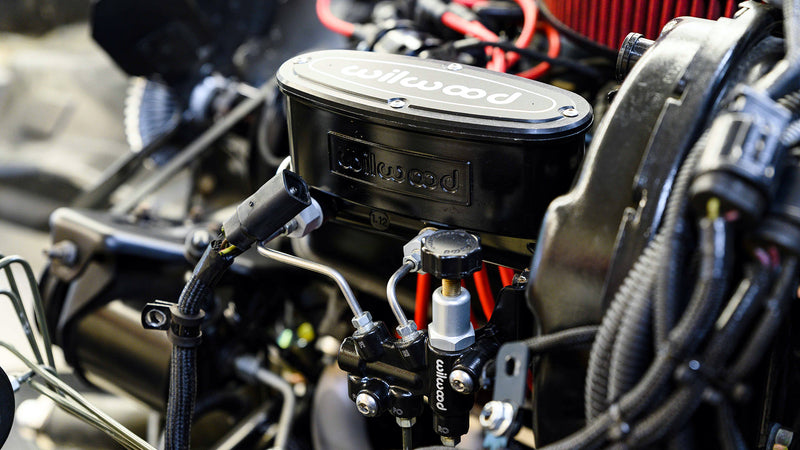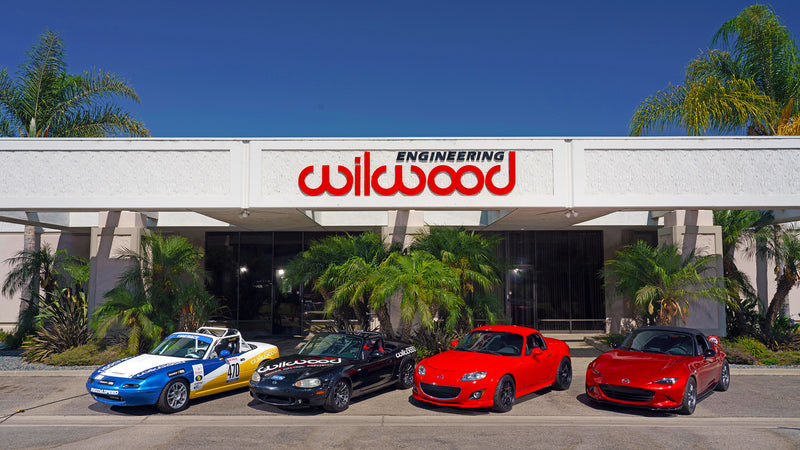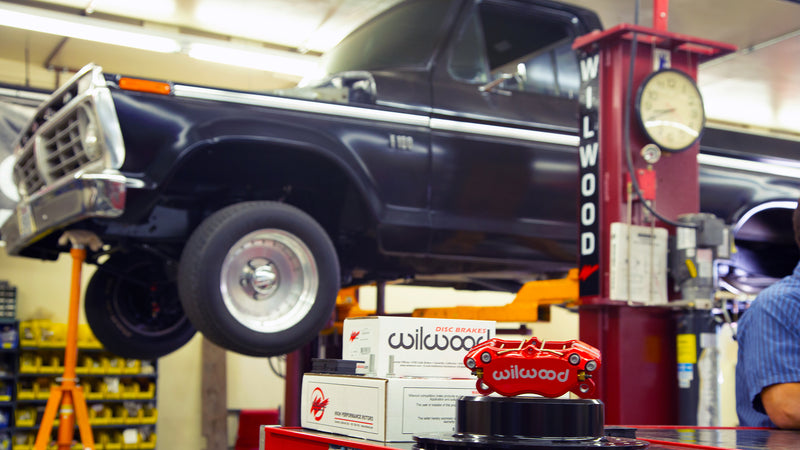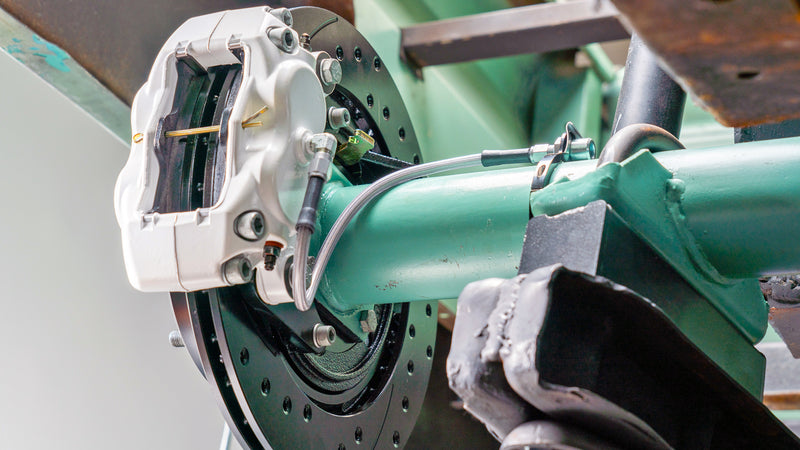
Many popular hobby cars come from the era when power brakes were an extra-cost option, and drum brakes were the norm. While Wilwood prefers manual brake systems, a holdover from our racing roots, our calipers and master cylinders work equally well for power or manual brakes. If you are just planning your build, now is the time to decide if you are going to go with boosted brakes or not.
When planning a performance manual brake system, such as for a race car, muscle car or street rod, getting the pedal and hydraulic ratio correct is even more critical. The hydraulic ratio relates the master cylinder piston size to the piston area in the calipers. The pedal ratio is the relation of the pedal pad, master cylinder pushrod, and brake pedal pivot. Both amplify your muscle effort to help the car stop, with or without a power booster. Get them both right, and even with manual brakes, you'll be able to stop your car or truck on the proverbial dime.
Power Assist vs. Manual Brakes
For some projects, the question of power assist or manual brakes is merely a personal preference, but the choice is forced on you for others. For example, often shoehorning a big motor into a small engine compartment leaves no room for a vacuum booster on the firewall, even with an angled (Ford Bronco) or offset (many vintage vehicles) mounting bracket. Other times, the radical cam timing of a high output motor doesn't create enough vacuum to power a traditional vacuum booster.
Manual Brakes

Because you need to be more precise when racing, and every datum of feedback can help make you faster, many drivers prefer the finer control and feel of manual brakes. When the brake pedal ratio and master cylinder bore are appropriately chosen to match the calipers and pad bite, leg effort won't be excessive even compared to a power-boosted unit. For this reason, many drivers prefer non-assisted brakes because they are easier to modulate and threshold brake at the edge of lock-up.
Getting the pedal ratio (and master cylinder bore size) right is critical for a non-boosted brake system to work well and not fatigue your leg in hard driving. It is impossible to give a hard number that works for every vehicle, but you want a pedal ratio of more than 6:1. The size of the master cylinder piston is even harder to pinpoint, but typically it should be less than 1". Researching the size of the factory unit originally fitted with unboosted manual brakes is a good place to start.
Vacuum Boosters

Figuring how much assistance you get from a vacuum booster is simple math. A mildly tuned engine with 16-inches of vacuum at idle translates to about -8 psi (actually 7.86, this is complicated to explain, so Google the conversion). So if you have -8 psi on one side of a small 7-inch diameter vacuum diaphragm booster (as small as they come) and regular atmosphere on the other, it adds about 300 pounds of assist when you hit the pedal.
To get that number, multiply the diaphragm area in square inches by 8 psi (ignore the negative nature of the number). The surface area of a circle is found with the formula of A = π x r2 (we'll pretend the dead area in the center of the diaphragm with the pushrod isn't there). If it has been a while since high school geometry, that means 3.14 x half the diameter x half the diameter. In this case, 3.14" x 3.5" x 3.5 = 38.465 sq. inches x 8 psi = 307.7 pounds of force.
A larger diameter booster gives more boost; moving up to an 8-inch size adds an extra 100-pounds. The math works like this, 4” x 4” x 3.14 = 50.24 sq. inches x 8 psi = 401.9 pounds of force. A dual-diaphragm booster doubles the area and the boost.
But you need vacuum to use any booster, and you need room to mount it. If the only issue is a lack of sufficient vacuum from the engine, a vacuum pump may be the simplest solution. Some vehicles used a motor-driven vacuum pump mounted to the rear of the alternator from the factory. There are also electric vacuum pumps available.
Hydro-boost

Another solution is to use a hydraulic assist, or Hydro-boost, system. These units can be found in the junkyards or purchased new from aftermarket suppliers. GM used hydraulic brake boosters between the master cylinder and firewall on many 3/4 and 1-ton trucks (and the Buick Grand National), and Ford used one on the 1999-2004 Mustang because of a lack of space.
Hydro-boost (Bendix's name for the system when invented in 1973) uses pressurized fluid from the power steering pump instead of engine vacuum to amplify your leg effort. Of course, you need a power steering pump to make it work, but it is just a matter of plumbing if you already have power steering.
How much boost you get is dependent on how much pressure the power steering pump puts out, but more than 1000 pounds is typical. Hydro-boost works the same no matter the throttle position or engine load, unlike vacuum.
Off-road trucks and buggies have adopted Hydro-boost because it allows drivers to control low-speed crawling with oversized tires. Just a little effort on the pedal can deliver 1500 pounds of force to the master cylinder.
Conclusion
There is a reason that all the automakers stick with vacuum-assisted power brakes - it is an affordable and mostly trouble-free system. For most people building most cars, it is probably the default option. An auxiliary pump can still make this a viable option if you don't get quite as much engine vacuum as you need.
For power brakes for your big tire off-road truck, with really low gearing and lots of torque, Hydro-boost is an increasingly popular option. Hydro-boost can also free up some room under the hood for a big block or OHC V8.
But Wilwood does sell many unassisted braking systems to racers in the top classes around the world. Nothing beats full manual when you are trying to modulate the brakes for that last sliver of competitive edge. If you figure your pedal ratio correctly and use the appropriate bore size master cylinder, you can have manual brakes that stop with authority without undue leg effort.
If you need more technical help figuring out your brake system, email the Wilwood tech staff.




John,
Are you saying you can’t find the Mustang pedal with the correct ratio to work with a vacuum booster for your 1966 Ford Mustang?
Often times the OEMs make things easy, with one pedal arm having two holes in it, which lowers the ratio from 6:1 to 4:1 depending on which you use. However Ford did not do this.
I believe the original 1964-66 factory booster had a bell crank and offset bracket which reduced the ratio, and used the manual brake pedal. These bracket and linkage setups are available online from various sources.
From 1967-69, Ford went thought the trouble of making a longer pedal arm with a pivot mounted higher up under the dash, so that the master cylinder mounted at the same height on the firewall. You can’t just swap in a manual 1967 brake pedal for a longer power brake pedal, you need the part it mounts to under the dash.
Building a 66 mustang coupe. I have wilwood 6 piston up front and 4 in the rear, both with the 12.19 rotors. Just picked up a wilwood mc 15/16 bore. I would like to run a brake booster but can’t find any pedal ratio that would work. Any advice would greatly help. Thanks
Dennis,
Your 1965 Falcon Ranchero, like almost all four-wheel drum brake cars built before 1967, would have come with a single circuit master cylinder, with one piston pumping the same pressure to all four corners. Starting in about 1967, for safety reasons, the government mandated dual circuits, with a master cylinder with two chambers, pushing some fluid to the rear and some to the front. In order to use Wilwood kit 140-13476, or any front disc brake conversion, you’ll have to update your car to the later dual circuit master cylinder. That also means running at least one additional hard line, so that the front and rear brake systems are no longer linked.
I am no expert on this era of Ford, but you should be able to find a factory replacement master cylinder that bolts up without any modifications. Look up a master cylinder for a 1967 Falcon with optional disc brakes and compare the mounting flange.
If you need more technical help, call our staff at 805-388-1188, Monday to Friday, 6am to 5pm pacific time.
I have a 65 Ford ranchero v8 289. Do I need to install a new master cylinder with a front brake conversion thinking about using kit 140-13476 any recommendations
hello,
I have a 1963 Ford Falcon that I’m currently building in a straight axle gasser style. I will be using manual brakes, due to limited space. I’ve done the math and found my pedal ratio to be 5.5/1. My front disc brake caliper piston area is 4.91". I am not sure yet of my rear disc brake caliper piston area. But, because I took the rear end out of For Explorer that came with a 4.10 LSD differential. I’m going to guess i have the larger 1 7/8" piston. giving me an area between 2.78 and 3.14. Can you recommend a master cylinder bore size that will give me all the stopping power I need. without needed a gym membership? Thanks
Hi. I got manual 6/4 piston Superlites on my 65 Fastback and it brakes fine with a decent amount effort but the pedal is so stiff, it barely moves. I also have trouble with closing pressure switches for brake lights. Any thoughts?
Jim,
We suspect the “pre-load” you are experiencing is due to the residual pressure valve built into the drum brake master cylinder, designed to overcome the return springs holding the brake shoes.
Our technical staff will email you directly for more information to help you choose the correct master cylinder.
We should be able to provide one that works for a later brake upgrade as well.
I have a 1963 Corvette coupe with all 4 – 17" wheels on Wilwood 12" rotors. Still using the original master cylinder with power brakes that is factory original. Brakes seem to pre-load continually and we have shortened the arm on the brake pedal to reduce pre-load. Tech says we need to replace original one line master cylinder with new Wilwood compact tandem M/C kit. I want to keep power brakes. Which M/C kit should I order?
Also, will the same kit work for 14" rotors if I switch to larger wheels and 14" rotors next year??